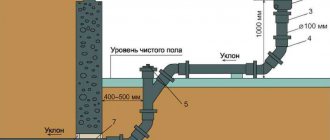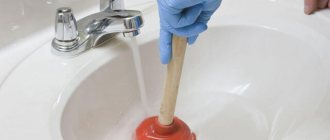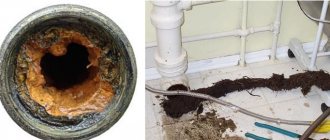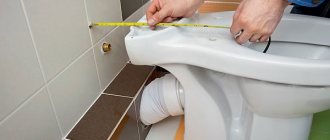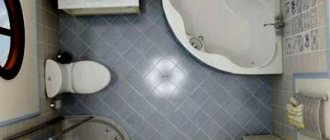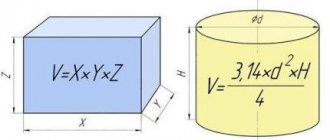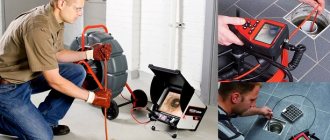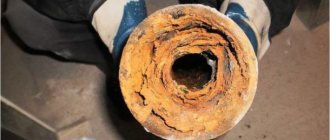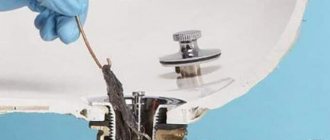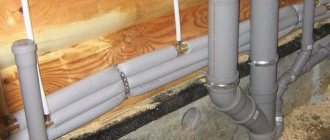A clogged sewer is always a problem, and it doesn’t matter whether the problem happened in a private house or in an apartment building. In the first case, the homeowner will have to deal with the unpleasant odor and, possibly, the backflow of drains on their own. In the second, discontent among neighbors is inevitable.
How to clean the sewer quickly and effectively without calling specialists? What products and tools should I use to quickly remove the blockage? Our article discusses the most popular and effective options.
What causes a clogged sewer?
In addition to the inevitable contamination of drain pipes with human waste and lime deposits in tap water, there are other factors that influence the extent and frequency of necessary cleaning measures:
- mechanical inclusions. This could be toilet paper, small items (accidentally or intentionally dumped down the drain), or household waste. Removing relatively large things is only possible mechanically; small ones can “come out” of the pipes into the riser on their own when dividing the congestion into separate fragments using cleaning agents;
- chemical deposits. This, oddly enough, includes fat - with frequent washing of dishes without the use of detergents, it is deposited on the walls of the pipes and gradually reduces their clearance. Accordingly, the risk of mechanical congestion increases;
- malfunction of the siphon. This may be due to both mechanical and chemical clogging of the container, and the smaller the diameter of the outlet pipe, the higher the likelihood of accumulation of fat, organic deposits or mechanical debris in the siphon;
- sewer design error. This is the most difficult and unpleasant case, since it cannot be corrected with improvised means. If such a problem occurs in a new house or apartment, you will have to redo the entire system or at least partially replace the bottlenecks. One of the common mistakes is an incorrectly chosen angle of inclination of pipes (beds) or their incorrect installation.
Removing sewer clogs is quite simple if preventative flushing and cleaning measures are carried out regularly. For heavily clogged pipes that have not been cleaned for a long time, the problem may not be solved with home remedies - in this case, you will need the help of a professional plumber, or even replacing part of the sewer system.
General information
Attention! Weak liquid pressure in the pipes indicates that a clogging process has begun.
The appearance of an unpleasant smell from the sewer should not be considered a sign of a blockage. The stench appears in rare advanced cases. It is caused by something other than a blockage.
Attention! The water seal mechanism protects the room from odors and harmful gases escaping from the sewer, while the element itself is considered the most vulnerable of the entire system.
If a blockage has formed in this device, the water does not pass through the drain hole, but remains in the bowl of the toilet or sink.
The cause could even be paper that has fallen into the sewer.
If a problem is discovered, it should be addressed immediately.
The water seal is equipped with:
1. Sinks with sinks, bathtubs, and trays in shower cabins are equipped with siphons.
2. Bathrooms, laundry rooms, and garages are equipped with drains.
3.knee inside the toilet.
4. The drain hose in a dishwashing machine or washing machine is installed with a lift, or a special device is installed.
There are devices in every sewer system, except for simple country houses.
The appearance of a blockage in the water seal can be easily eliminated with your own hands.
What causes pipes to become clogged?
In order to remove the plug without harm to the system, you should find out the cause of the blockage, then begin cleaning.
In a private home, blockages can appear for various reasons.
1. a large object getting into the sewer.
A large object that gets into the pipe can get stuck, and other elements begin to accumulate around them and are washed down the drain.
Hair caught in the drain hole is also a common cause of blockage. The hair gets wrapped up, forming a knot that cannot be washed off.
This plug is removed using cleaning agents or mechanically.
Attention! The plug from the hair is removed independently; most often, the blockage is a siphon; sometimes a cable is used.
Flushing a large piece of paper down the toilet can clog the system.
2. fats and lime accumulated on the walls.
Solids sticking to the walls narrow the passage of the pipe. Flushed waste causes a blockage.
Waste may contain substances of inorganic or organic type.
After washing dishes, fats settle on the inside of the pipes, and over time a thick layer of deposits forms.
If there is hard water in the pipeline, then the salts contained in it also settle on the walls, especially on metal ones.
To prevent the problem, grease traps are installed on sewer pipes. Devices in the form of filters purify water, compact to use.
3.clogging due to soap.
Soap clogs form if you use soap in the sink frequently. The soap solution, mixed with other waste, hardens on the walls. It is difficult to remove.
If the pipe is still functioning, then it is flushed with hot water; if the method does not work, radical methods are used.
Frequent blockages can be caused by improper pipe laying. If water flows through areas with difficulty, the risk increases many times.
In this situation, communications repair will be required to eliminate errors.
How to clean the drain in an apartment
If problems arise with drainage, you must first:
- locate the jam. Most often these are siphons of sinks, sinks, bathtubs, and less often - toilet bowls. If the water does not drain in only one plumbing fixture, but there are no problems in the others, it means that the problem is in the siphon or the pipe coming out of it. If the drainage is difficult or absent in all apartment plumbing, it is necessary to check the pipes, risers and deck chairs. If difficulties arise in several apartments at once, the problem is almost certainly the riser. Such a case requires the intervention of house plumbers; the blockage cannot be eliminated on your own;
- try to clean the drain with soda and vinegar, boiling water, or special means. In this case, it is necessary to take into account the type of pipes (metal or plastic);
- if there are no results, use a plunger (acceptable only for local contamination) and/or a cable (pipe cleaning);
- If the described measures do not work, calling a plumber is required. Otherwise, a “local” problem can very quickly develop into a general one for the entire riser, or even the house as a whole.
Improve, Organize and Support: Septic Tank Maintenance Tips
Cleaning the backup or sewer line of a septic tank is a dirty job that you can start and a professional will finish. Or leave the case entirely to a specialist.
If you have a flood and decide to do the cleanup yourself, before you start cleaning your drains at home, protect yourself from smelly, bacteria-contaminated sewage by wearing rubber boots, gloves and a mask. Once protected, follow these steps:
- Scoop up solids into a heavy plastic bag and dispose of them in the trash.
- Absorb liquid with paper towels or rags and dispose of in plastic bags.
- Use a wet/dry vacuum for small areas or suck out remaining puddles. (Before you can dispose of the contents, you need to clear the drains.)
- Place plastic sheathing on the floor to prevent contamination of other parts of the house.
- Place all damaged and undamaged items - outside.
- Tear up and throw away carpets and upholstery.
- Wash the area thoroughly with a solution of bleach and water mixed in a 1:1 ratio.
Unfortunately, these measures will only help get rid of the smell temporarily. Help clean up the wastewater by opening windows and using fans and dehumidifiers to release the air during the week.
How to clean a sewer in a private house
The algorithm is almost the same as for an apartment in an apartment building. There are also nuances:
- in small buildings built according to an individual project or without one at all, errors in the calculation and installation of water supply and sewerage systems are more common. Therefore, it is necessary to take into account the increased risk of sewer blockage in a private home;
- to the traditional causes of pipe clogging is added the risk of overflowing the septic tank (septic tank) or clogging of the drains leading to them;
- since, in addition to communications inside the house, there are also drainage systems outside (storm drainage), its cleaning is also required from time to time, especially after heavy rains or rapid melting of snow.
Important: when building a private house, it is necessary to ensure free access to the sewerage system at all key points, otherwise cleaning the sewerage system and removing blockages at home, as well as by professionals, will be very difficult.
Determining the location of the blockage
It is better to prevent the need for sewer cleaning in a private home in advance than to fix a problem with its functioning in an emergency manner. Measures related to regular prevention of blockages can reduce the likelihood of their occurrence to a minimum.
Finding a place where the sewage drainage system is clogged is often a difficult task, especially if it is not done by a professional. Usually, a clogged sewer in a private home does not happen instantly - the garbage collects gradually. It accumulates in some place in the pipe and prevents the free movement of liquid through it.
Thus, the main sign of the formation of a traffic jam and the fact that sewer blockages will soon need to be cleared is a violation of the drainage from plumbing fixtures. A disgusting smell from the pipeline due to the fact that dirt and solid fractions have accumulated inside it in the presence of a water seal appears very rarely if the system is in a neglected state.
As a result, water, if a dense blockage forms, stops leaving the sink and toilet and remains there. Often the reason for the need to clean sewer pipes is the irresponsible flushing of small household waste and ordinary paper down the drain. To prevent an accident, the problem should be resolved promptly.
Water seal present:
- On sinks, sinks, trays in bathrooms and shower rooms by using siphons.
- Drains are installed in laundry rooms, bathrooms, garages and washrooms.
- Toilets are equipped with a built-in elbow.
- In washing machines and dishwashers, it is organized using a drain hose with a lift, or using a special device.
It is water seals that are considered to be the place where garbage plugs accumulate most often. These elements are available in every sewer system, except for primitive drainage structures that are laid in some summer cottages.
Home remedies and store-bought chemicals
As already mentioned, when the question arises “what to do if the sewer is clogged,” you should first resort to thermal or chemical cleaning. These include relatively simple options for action.
- Using boiling water. The best option for metal pipes and not very suitable for plastic ones. The essence of the method is to pour a large amount of boiling water or boiling water with soda (a pack of soda for 5...7 liters of water). Removing a sewer blockage in a private house or apartment in this way is permissible only if the location of the blockage is determined - in the siphon or pipe next to it, but otherwise the system is functioning properly. Boiling water dissolves fat well, helps accelerate the dissolution of soap and separates solid particles, including toilet paper. At the same time, feminine hygiene products, baby diapers and other similar items that accidentally fall into the drain can swell even more as a result of the use of hot water and worsen the situation.
- Soda and vinegar. This cleaning option is the best remedy for blockages in sewer pipes with “local” problems, including kitchen sink drains. The peculiarity of the manipulation is the launch of a chemical reaction directly in the pipe or siphon. To do this, pour 0.5 cups of baking soda into the drain and pour in the same amount of vinegar 6% or 9%. After 1…1.5 hours, the pipes are washed generously with warm or hot water. This method is not very suitable for plastic pipes, since it gradually thins their walls.
- Industrial compounds. They can be alkaline or acidic, the first type is more suitable for kitchen drains, the second - for a bathroom or toilet. You cannot mix different products! When using them, follow the manufacturer's instructions. Different products are suitable for different types of pipes.
Important: the frequency of cleaning using these methods varies. Boiling water (without soda!) can be used almost every day, soda with vinegar - once every two to three weeks, chemical agents usually no more than once a month (depending on the composition and concentration).
DIY sewer cleaning
Advertised liquid, gel and granular compositions intended for eliminating blockages and cleaning pipes usually have a local effect. That is, they are able to temporarily clean the pipe in the nearest 1-2 meters from the sink or toilet. But harm is caused to the entire sewer system, especially if cast iron or steel pipes are used for its installation.
In addition, the use of chemical reagents with acids and alkalis is directly contraindicated if the wastewater is discharged into a septic tank with activated sludge. Chemicals kill all living things, and wastewater treatment plants cease to fulfill their function.
It is safest to use products that, when released into water, form foam that loosens blockages and many types of deposits on pipes. And the most inexpensive of the foaming reagents can be made yourself according to an old grandmother’s recipe: pour baking soda into the drain and pour in undiluted vinegar.
A traditional plunger will help get rid of the most common blockages that occur no further than 0.5 m from the sink or toilet drain.
A more “long-range” cleaning tool is a traditional plumbing cable, which is a long steel spring with a handle. It's easy to use, but the procedure itself is very messy. It is much more convenient to work with manual turntables, in which the cable is wound into a drum. With this tool you can effectively and without dirt clean the entire internal sewer system, where blockages most often occur.
If the blockage has occurred in an external sewer, then professional equipment is required to eliminate it - a drum or rod type cleaning machine. There are special companies that deal with sewer cleaning. So, in Moscow and the region, the owner of a private house will have to pay from 3 to 6 thousand rubles for calling a professional with cleaning equipment. Services include video diagnostics before and after cleaning.
A clogged sewer pipe: how to break it mechanically
If hot water and chemicals do not help, the inevitable question arises - how to break through the blockage in the sewer. There are two traditional options - a plunger and a cable. The first “tool” is a rubber bowl on a wooden or plastic handle, which, by creating a local vacuum (the principle of operation of a mechanical pump), facilitates the release of water, air and debris from the pipes.
The plunger is installed so that the rubber valve (return bowl) completely covers the drain hole, and a forward-return movement is performed. In this case, the water in the sink (sink) should completely close the valve of the plunger. An example of working with this device is shown in the video. It is especially effective to use a plunger to remove a clogged sewer in an apartment if it is caused by an “air lock” in the pipe.
If the plunger does not have the desired effect on the sewer, you should use a cable. At the same time, for inexperienced users, the question of how to clean a sewer pipe with a cable and whether its use is permissible for a system made of plastic pipes is very acute. Experts advise: before clearing the sewer with a cable, you should use chemicals and a plunger to remove “nearby” blockages. After this, the cable is inserted into the pipe, pushed all the way and carefully turned until the blockage is removed. How to clean a sewer in a private house or apartment using a cable is described in more detail in a short video.
If using a cable seems excessive, you can think about how to clean sewers made of plastic pipes using the hydrodynamic method.
This method is usually used by specialists, since it requires the use of professional equipment. However, if the water from the system is drained and the blockage remains, you can try to remove it using improvised means (this is suitable, in particular, for storm drains). A hose with a compression nozzle is inserted into the pipe, the other end of the hose is connected to the water supply. Under pressure, water flushes debris and organic deposits from the pipe walls.
Construction of houses
-16 votes
+
Vote for!
—
Vote against!
Clogging of the drain occurs even with the most careful use. This is a big nuisance that is sometimes not very easy to deal with. The sewer system is a pipeline running from the taps and toilet to the drainage pit. You can prevent blockages in different ways, but it is still better to try to avoid such situations. Let's look at what causes blockages in pipes, how to clean pipes, and what the most effective methods are.
Table of contents:
- Causes of clogged pipes
- How to clear clogged pipes at home, the necessary tools and equipment
- Ways to remove blockages
- Chemical methods for removing blockages
- Mechanical methods for clearing blockages
- How to effectively deal with clogged bathroom pipes at home
- How to clear clogged pipes in the kitchen at home
- How to clear clogged pipes at home without ruining them
- Cleaning plastic pipes
- Preventing blockages
Causes of clogged pipes
The cause of any blockage is the accumulation of foreign substances in a specific place. They block the passage of water. The most common sources of such cases are:
- paper - toilet paper does not very often cause blockages, it is quite soft and dissolves in water, we are talking about newsprint, it collects in a lump at the places where pipes turn or before the toilet flushes;
- rags - these items end up in the sewer system when emptying buckets or basins after cleaning the room or when directly flushing the machine into the toilet - compressed fibers can tightly clog the drain;
- wool and hair are a common cause of clogged pipes under shower stalls and bathtubs;
- sand and earth particles - they end up in the system after washing shoes or animal paws, these substances are collected in the siphon;
- fat - not only after washing dishes does fat end up in the pipes, clogging the sewer, this also means soap containing some amount of fat, fat deposits most often form in the knees, in these places the drained water sits for some time and fat is deposited on the walls of the sewer pipes
There are many more reasons for clogged sewer systems, but this is when we talk about multi-apartment high-rises, whose residents often dispose of food waste, cat litter and similar things down the drain. In private homes, the attitude towards drainage is more reverent. Therefore, these reasons are the most common in a private home.
How to clear clogged pipes at home, the necessary tools and equipment
Finding out the cause of the blockage, especially if it occurred against the background of relatively stable sewerage operation, is not difficult. It is enough to find out from each family member whether any actions have been taken in relation to the toilet? Did a large amount of toilet paper, or a sponge, or any other item get there? Typically, the answer will clarify everything.
If the water flows with force for a long time, for a long time, and the rest of the plumbing fixtures are working properly, it means that the blockage has occurred specifically in the place of the siphon, elbows or outlet of this plumbing item. Gradually settling substances, fat, food residues after washing dishes slowly but steadily worsen the quality of waste water, clogging the drain.
If the blockage happened unexpectedly without objective reasons, you can find out the location using plumbing fixtures. You should see which item has reduced the quality of throughput and look for the reason in this place.
Ways to remove blockages
At the moment, there are many effective and efficient ways to remove blockages. From old-fashioned methods using soda to using the latest household chemicals for cleaning pipes.
Even though the sewer system will be equipped with special filters, it is not always possible to avoid blockages. Perhaps, at least once in their life, everyone has encountered a similar problem. Don't despair. There are three main ways to remove a blockage, and knowledge of the theory will help you apply the methods in practice and eliminate the blockage even before the substances in the pipe become seriously compacted.
These are the options:
- chemical method using special household chemicals;
- mechanical method using devices and tools;
- hydrodynamic method using high water pressure.
Let's take a closer look at the most popular options.
Chemical methods for removing blockages
The use of modern chemicals allows you to quickly and effectively deal with a large number of blockages. In stores you can see a huge assortment of goods, such that without outside help you may not be able to figure it out. The products are sold in various forms:
- liquid;
- gel-like;
- granular;
- powdery.
The similarity between all these forms is in the main component - the basis of each remedy is caustic soda. Thanks to the substance, you can easily dissolve fat, small debris, and organic deposits.
This method of removing blockages is considered very fast. Chemical ingredients, spreading through the sewer system, envelop the inner surface of the pipes and break down organic deposits. So when trying to clear clogged pipes, you should give preference to liquid products. Solid and powdery ones act on deposits or blockages fragmentarily and only partially remove accumulations. There is no point in chasing a brand when purchasing such a product; caustic soda is equally effective in combating blockages in a product from any manufacturer.
When purchasing a product, pay attention not to the price, but to the consistency.
But it should be understood that not all pipes can withstand the aggressive effects of chemicals. Depending on the material from which the pipes are made, you should buy the product. Caustic soda should be used wisely so as not to harm the integrity of the pipes and human health.
There are strict rules when using household chemicals:
- to avoid serious chemical burns, you can only work with drugs while wearing gloves;
- It is highly advisable to use a respirator to protect the respiratory system from toxic fumes.
You can use chemicals to remove blockages and prevent their occurrence. For example, when using drugs once every ten days, you can completely protect the sewer system from blockages. Fats simply will not be able to have time to be deposited and accumulate, retain other debris and clump together.
Mechanical methods for clearing blockages
Mechanical methods of blockage are carried out using some devices or objects. Let's look at the most popular options:
- if you know exactly what caused the “sharp” blockage, you can remove the item with your hands, protecting them with rubber gloves; if you don’t have gloves, wear plastic bags;
- if you fail to reach the object with your hands, you can use a rigid wire with a bent end in the form of a hook;
- using a plunger, hydraulic shocks can push the blockage out of the narrowest area;
- a plastic bottle can replace a plunger if you don’t have one.
If mechanical methods were not effective, a chemical method is used.
How to effectively deal with clogged bathroom pipes at home
Clogs in the bathroom can be caused by clumps of hair, soap residue, dirt, animal hair, and similar items. In this case, clogging occurs gradually: at first the water drains more slowly, then poorly, and as a result, it may not drain at all. This can cause big trouble. But before you call a specialist, you should try to clear the blockage in the pipes yourself.
As a rule, a plunger is an effective way to remove a clogged part of the system at home. This device is only effective when cleaning the bathtub. The algorithm for solving the problem is as follows:
- To ensure that the water pressure does not decrease during operation of the plunger, the overflow hole is plugged and water is drawn in;
- it is necessary to place the plunger over the drain hole and press rhythmically to create high pressure, the plunger is removed sharply, this forces the stray lump - the cause of the blockage - to move from its place and cease to be a monolithic mass;
- if there are no changes, it is recommended to pour boiling water into the drain pipe and after a short time repeat the steps with the plunger.
As a rule, such manipulations will help to influence the blockage and eliminate it without contacting a plumber. Using boiling water will ensure that the clog is broken through.
There are other options for removing clogs in the bathroom. You need to know them in order to promptly and effectively influence an unpleasant situation.
No less effective is the use of a plumbing cable: this is a thick, rigid wire with a spiral. The tool is used as follows:
- a bucket or any other container should be placed directly under the siphon;
- carefully dismantle the siphon and inspect it to see if it is clogged with debris, clean it if necessary;
- install the siphon in place;
- if nothing has changed and the water drains slowly or does not drain at all, then the pipes need to be cleaned;
- the siphon is removed again and the plumbing cable is immersed in the pipe;
- as soon as the cable hits something that offers resistance, turn the tool to the right and jerk, pull out the device and clear the debris from the end of the cable;
- there is no need to act with force, otherwise the device may break in the system or damage the integrity of the pipes.
You should clean plastic pipes very carefully, as there is a risk of damage.
How to clear clogged pipes in the kitchen at home
You can clear a clogged pipe in the kitchen using any of the following methods. Or you can use folk methods that give effect. Here are some of them:
- Using soda and vinegar is a simple, economical and effective option: take soda and vinegar in equal quantities, pour soda into the drain hole, pour vinegar on top, close the hole for a couple of hours, after this time you need to pour hot water into the drain hole. This is an inexpensive method that will clear the blockage and will not damage the structure of the pipes. This method can also be used to prevent blockages in the future.
- Heat the soda in a dry frying pan for about twenty minutes, cool and dissolve in water, pour into the pipe. In terms of effectiveness, this method is comparable to a chemical pipe cleaner, but while providing the same effect, it is gentle.
- Using lemon is a safe and reliable option for removing clogs. Squeeze the juice of one lemon or pour a bag of lemon juice into the drain hole.
- A concentrated saline solution also helps remove foreign matter from pipes, and it is preferable to use a plunger in this method.
How to clear clogged pipes at home without ruining them
When trying to remove a blockage, you should remember that the irrational use of chemicals can cause failure of plumbing equipment. Using products without taking into account the characteristics of pipes and their material can damage structures. Therefore, you need to choose a household chemical to remove the blockage taking into account the material from which the system is made and the type of blockage. Metal or cast iron pipes clog faster, are susceptible to corrosion and easily accumulate deposits on the walls. Plastic pipes become clogged less frequently and are easier to clear. A plunger or chemicals effectively clean these types of pipes. Mechanical or chemical methods are more suitable for metal pipes.
Cleaning plastic pipes
Due to their smooth internal surface, plastic pipes are less likely to become clogged, unlike cast iron pipes. But if a blockage occurs, then most likely it is either a bend or a turn in the system. This type of pipe can be cleaned using chemicals intended for plastic. In general, pipe cleaning products have already been listed, to summarize, we can say that the blockage is eliminated as follows:
- special chemical preparations, often if one has a bad result, another means is used, and it gives results;
- traditional methods;
- plunger;
- mechanical means - extremely carefully.
Preventing blockages
To avoid blockages, preventive maintenance should be carried out systematically. A set of preventive actions will allow you to avoid troubles associated with clogged pipes and eliminating the defect. It is recommended to install special catchers - filters and fine mesh. All turns, elbows and joints should be equipped with inspection hatches and openings to monitor the condition of the pipes.
For prevention, the system is periodically washed with boiling water, solutions of soda and vinegar. Care should be taken to ensure that large particles of debris do not enter the sewer system along with water. Taking these simple measures will help keep the sewer system in order.
If you still have questions about how to clear the blockage yourself, watch the video on how to clear a sewer at home and feel free to start eliminating the troubles. Doing this work yourself is quite affordable.
What to do if the sewer is clogged or when to call plumbers
All the described methods for eliminating problems with sewer pipes only work if you have the appropriate means and tools, as well as at least minimal skills in using them. If there is nothing at hand, and the problem with the drain grows and threatens to turn into a full-fledged problem, you should give up trying to solve the problem on your own and call in professionals. In addition, an immediate call to plumbers is necessary if:
- water flows from the drain pipes or toilet even outside of flushing;
- after the water supply stops, the reverse flow from the sewer continues;
- the unpleasant odor from the drain intensifies and/or does not go away after flushing and cleaning.
Important: the question “the sewer is clogged in a private house, what should I do?” This is solved first of all by checking the condition of the drainage pit or septic tank.
The sewer is clogged, whoever can save himself
When the neighbors sniffle and peek over the fence. When you feel contagious, and inviting guests is out of the question. No, this isn't a medieval plague outbreak—it's your drain that's clogged. This is a local disaster!
When the sewer system in your house is definitely clogged, you will immediately understand, or rather, smell it...
Prevention measures
As already mentioned, clog problems occur when sewer systems are used incorrectly. To ensure that problems arise as rarely as possible, you should:
- Stop dumping food waste, toilet paper, personal hygiene products and garbage into sewers. To prevent accidental clogging, it is worth installing removable screens on the drains;
- use detergents and cleaners more often when washing greasy dishes and processing fatty foods;
- at least once a month use alkaline or acidic (according to indicators) products for washing siphons and pipes;
- at least once a year, disassemble siphons under sinks and bathtubs for mechanical cleaning and rinsing, as well as replacing seals and checking the condition of the system as a whole.
Of course, one should not neglect the initial quality of the design and installation of plumbing and sewerage: the better the installation is done, the better the components used, the fewer operational difficulties will arise in the future.
Important: when supplying tap water of poor quality (very hard, clogged with small debris) or frequent water shutdowns, it is recommended to install a coarse filter at the entrance to the apartment/house. This will reduce the risk of mechanical clogging of pipes and the percentage of lime and organic deposits on the internal surfaces of pipes.
Causes of blockages
Of the most common, the following should be highlighted:
- Accumulation of household dirt on pipe walls. Day after day, when draining the water, a small part of the dirt remains on the walls and is no longer washed off - sooner or later the water may simply stop passing through. The accumulation process is especially active when washing off hair and wool, water after cleaning, and pellets formed when washing clothes.
- Incorrect operation of pipes is, first of all, a lack of timely prevention (how to carry it out will be discussed later).
- Large objects that get into the system can accumulate in one place and form a blockage.
- Errors in the design and installation of pipelines. If the slope is insufficient, the angles are chosen incorrectly, and in general the architecture of the pipeline system is far from ideal, it will become clogged much more often. In such cases, sometimes it is even easier to redo it. For private houses, such problems are much more typical, since they can be caused by the characteristics of the topography and soil.
- A number of specific reasons associated with the outer part of the pipeline: in winter it can freeze, the soil can sag and damage the pipe, and the roots of nearby plants sometimes penetrate directly into the joints.
The most common cause of blockages is the accumulation of household dirt. To make it happen less often, it is worth examining separately what types of waste poured into the sewer provoke it. This:
- Paper - it is dangerous because it expands when wet, and this especially contributes to the appearance of plugs in the pipe.
- Fat deposits are primarily characteristic of pipes leading from the kitchen. Various particles stick to the fat, and it serves as a medium for the development of microorganisms that cover the inside of the pipes with sticky mucus, and an unpleasant odor often begins to emanate from them.
- Fabric particles - most often end up in the sewer after the water used to wash the floor or windows is drained - particles of the rag used for this remain in it. If they get caught on an uneven surface in the pipe or stick to grease, they will then accumulate dirt.
- Construction waste is one of the main enemies of sewage systems. You cannot pour the remains of various construction compounds into it, because they can quickly block the pipe. After just a couple of such drains, it may become impassable, and the blockage from construction waste is sometimes so severe that it is necessary to dismantle the pipes.
- Cat litter is based on clay, which sticks to the pipes and can completely block them quite quickly.
- Hair and fur – in themselves they are not such a big problem, especially since they mostly settle on the grates. But in combination with others they can greatly speed up the process of plug formation in the pipe.
